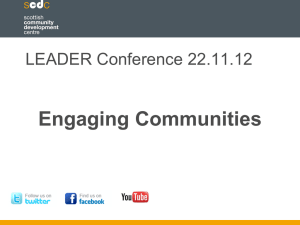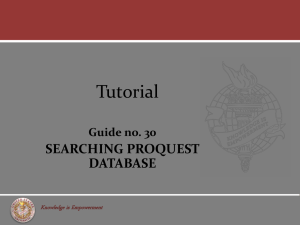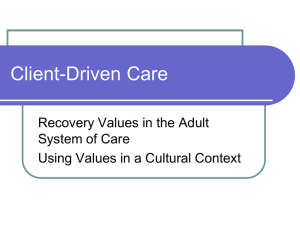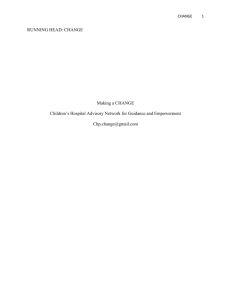Empowerment & Culture Presentation
advertisement
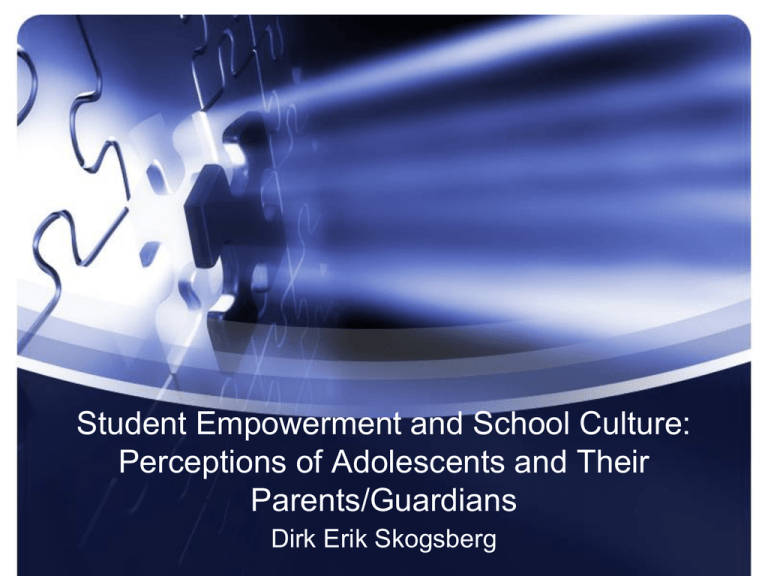
Student Empowerment and School Culture: Perceptions of Adolescents and Their Parents/Guardians Dirk Erik Skogsberg Problem Statement Middle Level Students – Adolescence - greatest changes (K-12) • Physiological • Psychological – Changes often impact academics and behavior What direct impact do students have on their well-being and subsequent learning? Purpose of the study: To explore the perceptions of middle level students and their parents/guardians of how student empowerment, through ownership in the learning community, impacts the school’s culture The question… What are student and parent/guardian perceptions of student empowerment, through ownership in the learning community, and the subsequent impact on the school’s culture? Significance of the Study • Students at this age/grade level are “caught” in the middle. • Expectations – Set by adults – Adolescent students are to model adult behavior • No student voice Review of Literature Key points - continued: • Adolescents & Adolescence • Culture • Ownership & Empowerment Adolescents & Social Development Level 3 – PostConventional & Principled Level 2 – Conventional Level 1 – Preconventional Stage 6 – Universal Ethical Principles Stage 5 – Prior Rights & Social Contract Stage 4 – Social System & Conscience Stage 3 – Mutual Interpersonal Expectations Stage 2 – Individual Purpose & Exchange Stage 1 – Punishment & Obedience According to George & Alexander: •Some will demonstrate a predominance of Stage 1 •Near age 10, some begin to enter Stage 2 •Middle level students are typically thought to be in Stage 3 •A very small population of middle school students will move into Stage 4 during their middle school years Adolescents & Adolescence, continued: • Beliefs and autonomy • Voice • Needs • Age vs. physiological • Stages / Levels Culture • Culture in General • Fostered Democracies • Culture & Change Ownership & Empowerment • Autonomy • Voice • Demarginalization • Ownership vs. Empowerment Methodology of Research • Sample Pool • Demographics • Interviews Limitations & Delimitations Human Subjects and Ethics • Students • Parents/Guardians Collection of Data • Collection • Accessibility • Record Keeping Pseudonyms / Aliases • Pseudonyms – – – – – Students Parents/Guardians School / Surrounding Schools Community / Surrounding Communities Others Triangulation of Data • Memoing • Recordings • Transcripts • Log Analysis / Coding • Emergent Themes • Repeated Review • Synthesis took place AFTER thorough analysis • Coding – Free nodes – Tree nodes Findings 1. Ownership 2. Make a Difference 3. Culture & Empowerment 4. Culture & Behavior / Achievement Finding 1 Ownership is brought about through empowerment of stakeholders. – – – – – Sense and embrace ownership Taking an active role – opportunity vs. action Taking the lead or playing a supportive role Self-imposed expectations by the students Demarginalization Finding 2 People Make a Difference Belief – In others – Oneself – Collective Whole Students – Ownership – Supported Student Outcomes: Know Differently Content wise Prepared for life Authentic learning and engagement with applications Think globally (with multiple foci) Use prior knowledge Believe Differently All students can be successful Overcome peer pressure Read for importance All students learn in different ways Self-directed learning Self-advocates Freedom & trust to discover new & interesting things Do Differently Care for others and act on it Student involvement Do something AS a learning community FOR the larger community Finding 3 The culture of a school can be changed as a result of student empowerment. – “Whose school is it?” – “How many does it take?” • X^1 – Change in Our • Values • Beliefs • Attitudes Finding 4 Change in school culture impacts student behavior and achievement. – Making choices, following examples – Giving opportunities for personal growth – Realizing your role Implications – Finding 1 Ownership is brought about through empowerment of stakeholders – Ownership of the learning community required that ALL stakeholders were valued – Future considerations… Implications – Finding 2 People Make a Difference • Staff – Supporting peers – Supporting students • Students – Supporting peers – Holding peers & teachers accountable Implications – Finding 2, cont’d. People Make a Difference – Future considerations… Implications – Finding 3 • Empowerment CAN Change Culture – Dependence – Culture Change as a JOURNEY Implications – Finding 3, cont’d. • Empowerment CAN Change Culture – Future considerations… Implications – Finding 4 • Culture Impacts Behavior / Achievement – Decrease in significant discipline – Increase in student academic achievement Implications – Finding 4, cont’d. Table 5.2 – Behavior Management Data (by school year) Suspensions Expulsions 2007-2008 94 9 2008-2009 75 3 2009-2010 51 0 Table 5.3 – Academic Performance (by school year) Assessment and Adequate Yearly Progress (AYP) Summer School Retentions 2007-2008 2008-2009 Improvement in Improvement all areas, and AYP in all areas, met in all areas and AYP met in all areas sans reading for “students with disabilities” 37 10 6 1 2009-2010 Improvement in all areas, and AYP met in all areas 16 0 Implications – Finding 4, cont’d. • Culture Impacts Behavior / Achievement – Future considerations… In summary– • Understand the perspectives of middle level students • Guide future professional practice of middle level educators • Make a connection between student empowerment, through student ownership in the learning community, and its impact on school culture • Specific consideration given to students as active stakeholders



